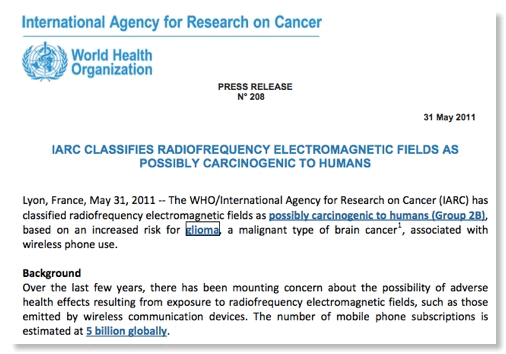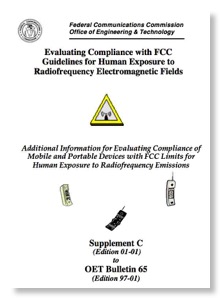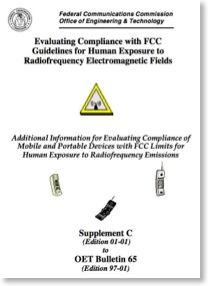FCC Dismisses Complaint Related to OETB65C RF Safety Issue

On December 20, 2012 FCC, in the above action, dismissed a complaint by Ms. Cynthia Franklin under the obscure provisions of the Data Quality Act (“DQA”) - a 2001 piece of legislation your blogger had never heard of before.
Before getting into the details of Ms. Franklin’s complaint, let me point out that document is a reminder of a more general problem of the FCC website even after there recent improvements: Despite the huge amounts of (poorly organized) data on the FCC website, this complaint and the supporting document are nowhere to be found because it is a “undocketed” proceeding that also lacks any file number. Thus its very existence was unknown to the public until the 12/21 date of the above Order. Indeed even now there is no obvious way to see the whole text of the complaint short of filing a FOIA request and having FCC staff then quibble over whether they should charge you to see this information. Is this really “a government worthy of its people”?
(I also note that as of the drafting of this post, a search of the FCC website on “Cynthia Franklin” yields no results at all!)
OETB65C
Back to the specific issue of Ms. Franklin’s complaint, this deals with an issue that has been discussed here repeatedly since November 2010: OET Bulletin 65, Supplement C (“OETB65C”). This document has as a title, “Evaluating Compliance with FCC Guidelines for Human Exposure to Radiofrequency Electromagnetic Fields Additional Information for Evaluating Compliance of Mobile and Portable Devices with FCC Limits for Human Exposure to Radiofrequency Emissions”. This document describes its function as:
The purpose of this revised supplement is to provide parties filing applications for equipment authorization with guidance on complying with the latest requirements using up-to-date test procedures. This supplement is not intended, however, to establish mandatory procedures, and other methods and procedures may be acceptable if based on sound engineering practice.
Thus it is not a “regulation” because it is not “mandatory”, but it does give a “safe harbor” showing equipment authorization applications what FCC will accept for compliance showing with RF safety issues. As Time Magazine pointed out in 2010,
FCC testing regulations notably chose not to simulate a situation in which the phone was broadcasting at full power while inside a shirt or pants pocket flush against the body, an odd oversight given the known habits of many cellular-phone users.
OETB65C was issued in June 2001 and lists 2 authors and 3 contributors. (Only one of these people still work at FCC and I suspect he had little involvement with the controversy at hand.) Your blogger worked in OET management at the time and had absolutely no involvement. Indeed, OET was under acting leadership in the early Powell chairmanship at that time as Ed Thomas did not arrive as its chief until early 2002. As quoted in the FCC Order (remember, the actual compliant is still not on the public record due to the website problems mentioned above), the Franklin complaint deals “three of the FCC consumer documents” arguing that “the documents should be corrected to state that cell phones are not tested for RF exposure during use in direct contact with the body, and therefore they should not be used in such a manner.”
The December 20 Order reaffirms OET’s October 2011 rejection of the Ms. Franklin’s compliant - a document also not on the public record. The grounds seem to be a narrow interpretation of the Data Quality Act. Perhaps thee grounds are even a correct interpretation of the Data Quality Act.
Here is a sample of the FCC’s logic:
Ms. Franklin’s concerns, however, misconstrue the purpose of the document at issue, which is not to provide advice on how best to hold and use a cell phone, or to allow consumers to critique the sufficiency of testing methods, but rather to explain why a single reported maximum SAR value is an insufficient basis for comparing the likely RF exposure from individual cell phone models. Indeed, the guide emphasizes that SAR testing “does not indicate the amount of RF exposure consumers experience during normal use of the device.” And while Ms. Franklin asserts that the guide will encourage consumers to carry cell phones against their bodies, the only statement in the guide about how to carry a phone is quite to the contrary, noting that “the most effective means to reduce [RF] exposure are to hold the cell phone away from the head or body and to use a speakerphone or hands-free accessory.”
So basically the document at issue is not guidance to consumers, so it doesn’t matter if it is misleading! It is just guidance to cell phone manufacturers on how to avoid the intention of the FCC’s RF safety rules and there is no Data Quality Act issue involved in that under FCC’s logic.
Cell phone industry: If you want to gain the trust of the US public on RF safety issue you should not hide behind such charades. While your blogger believes that cell phones as actually used these days are safe, the sordid history of OETB65C does not reflect well on the cell phone industry and FCC’s objectivity on safety issues. Better transparency is needed in the drafting and implementation of FCC Rules on RF safety to keep the public trust.
WashPost "FCC considers whether to study cellphone radiation"

A”phantom” often used for SAR measurements.
Simulated cavity is filled with special liquid to simulate body’s electromagnetic qualities.
Probe is inserted in simulated head to measure electromagnetic fired resulting from cell phone emissions and focusing or diffusion by body shape and its physical parameters such as conductivity.
Cell phone tested is under body cavity and can’t be seen in this photo.
(FCC also permits computer calculations of SAR that consider body shape and parameters.)
Last night the Washington Post posted an article on its web site that appeared in today’s print edition with the above title. The Post’s Cecilia Kang wrote:
The Federal Communications Commission is seeking to study whether it needs better guidelines to protect people from cellphone radiation, a question it hasn’t posed in 15 years…
The debate is sure to draw heavy interest. The deep-pocketed wireless industry opposes changes to current federal rules. Health advocates have argued that the government has ignored safety concerns raised by some scientists.
Studies have been split on the matter. Some have indicated that cellphone use poses no risk to humans.
Ms. Kang points out correctly that the 5 commissioners must vote to start any reexamination, something a little in doubt due to the cellular industry’s likely opposition and the degree that the current commissioners have focused on meeting the cellular industry’s spectrum demands - virtually ignoring former “top dog”- the broadcasting industry - in the process.
Historically, though, FCC has never really picked an RF safety standard. Since FCC is not a health and safety agency it has always deferred to a troika of such agencies (Environmental Protection Agency, Occupational Safety and Health Administration, and National Institute of Occupational Safety and Health) to recommend specific protection standards for the public and for occupational workers. FCC has consistently used standards that were proposed by the 3 agencies at the end of its rulemaking process. (Amusingly,a decade or 2 ago the Defense Department was embarrassed over the difference between its standard for exposure of GIs and the FCC occupational standard and sought a place at the table as a 4th “health and safety agency” so it could moderate FCC’s positions even though they did not legally apply to the exposure of GIs. FCC wisely rejected giving DoD an inside role with off the record participation as a “health and safety agency”.)
Readers are reminded of an earlier post on the “OETB65C problem” that the cellular industry no doubt would prefer remain “under the carpet”. While the Commission’s rules specify human exposure limits and set as SAR limit of 1.6 W/kg for the head, 47 CFR 2.1093, some of the key details for measuring the SAR and interpreting the rule is given in the more obscure OET Bulletin 65, Supplement C, “Evaluating Compliance with FCC Guidelines for Human Exposure to Radiofrequency Electromagnetic Fields:
Additional Information for Evaluating Compliance of Mobile and Portable Devices with FCC Limits for Human Exposure to Radiofrequency Emissions”, last revised in January 2001 - a time during the Bush 43 transition when it got little attention either within FCC or in the public and no notice and comment.
On p. 41-2 of OETB65C it states,
.Body-worn operating configurations should be tested with the belt-clips and holsters attached to the device and positioned against a flat phantom in normal use configurations. ... Both the physical spacing to the body of the user as dictated by the accessory and the materials used in an accessory affect the SAR produced by the transmitting device. ...Body-worn accessories may not always be supplied or available as options for some devices that are intended to be authorized for body-worn use. A separation distance of 1.5 cm between the back of the device and a flat phantom is recommended for testing body-worn SAR compliance under such circumstances. Other separation distances may be used, but they should not exceed 2.5 cm
Thus the manufacturer can use body separation of up to 2.5 cm (about 1 inch) to show compliance without either providing a portable device holder or even telling the buyer that it must be kept an inch away from the body, i.e. do not put it in your pocket! A truly great loop hole!
So in an open rulemaking FCC adopted the SAR standard of 1.6 W/kg and in a mysterious OETB65C drafting process the OET staff gutted some key provisions! Now the cellular industry’s lawyers think it can decrease its liability if any adverse health effect is ever found by saying that its products meet all FCC rules. Isn’t liability decrease for key FCC regulatees a key FCC function? Or was it supposed to be the public interest? I keep forgetting.
In any case, hopefully FCC will allow a public review of RF safety standards for the first time since 1996 and will avoid the transparency problems associated with the drafting of the current OETB65C by seeking either including key provisions in the rulemaking or asking for public comment on a draft.
New WHO Finding on Cellphones: Will CTIA Let FCC Take a More Proactive Stand?

Today the World Health Organization’s International Agency for Research on Cancer (IARC) released the above statement on a possible connection between “wireless phone use” and cancer.
CTIA’s ever quotable John Walls responded,
“Today, an International Agency for Research on Cancer (IARC) working group in Lyon, France categorized radiofrequency fields from cellphones as ‘possibly’ carcinogenic based on ‘limited evidence.’ IARC conducts numerous reviews and in the past has given the same score to, for example, pickled vegetables and coffee. This IARC classification does not mean cellphones cause cancer. Under IARC rules, limited evidence from statistical studies can be found even though bias and other data flaws may be the basis for the results.“The IARC working group did not conduct any new research, but rather reviewed published studies. Based on previous assessments of the scientific evidence, the Federal Communications Commission has concluded that ‘[t]here’s no scientific evidence that proves that wireless phone usage can lead to cancer.’ The Food and Drug Administration has also stated that ‘[t]he weight of scientific evidence has not linked cellphones with any health problems.’”
CNN posted the following video on the issue:
Your blogger agrees with the tone of the CNN video. There is no need to “freak out”, but we should try to reduce exposure in reasonable ways. This is something that has been proposed here several times along with references to to the proactive stance of CTIA’s French counterpart.
Unfortunately, CTIA and its members are still stonewalling behind the viewpoint that since cellphones meet all present federal standards, nothing else is needed. Industry sources tell your blogger that this is based in part on trying to limit industry liability if health problems are later found. I hope the public finds that reassuring and is glad to know that FCC supports CTIA’s parochial interests in this matter.
Gupta: Cell phones, brain tumors and a wired earpiece -- CNN
On May 20, CNN posted the above video with an accompanying article where Dr. Sanjay Gupta talks about cell phones and brain cancer. Besides being CNN's chief medical correspondent, Dr. Gupta is an assistant professor of neurosurgery at Emory University School of Medicine and associate chief of the neurosurgery service at Grady Memorial Hospital in Atlanta, Georgia. In 2009, it was widely reported that he was offered the post of Surgeon General in the Obama Administration but turned it down.
In the face of repeated alarmist claim that cell phone use causes brain cancer, CTIA and the cellular industry responds with stonewalling that this is no proof and that cell phones meet all government standards - both literally true. Critics though focus on brain cancer although occasionally mentioning a large laundry list of other pathologies - all without any credible evidence. Why the focus on brain cancer as a possible impact of cell phone use? Probably scare tactics from the anticellular forces since brain cancer is one of the scariest diagnoses around and it thus helps grab headlines. Other possible pathologies just don’t get the same headlines.
Faced with this emotion loaded but evidence lacking threat, CTIA responds with legal stonewalling which industry sources says is focused on minimizing industry liability if same adverse health effect of cell phone use is ever proven. That may be a reasonable lawyer-driven response for industry in such a situation, but is it a reasonable approach for a regulator acting in “the public interest”?
While RF exposure to your head may not be doing you any harm, it certainly isn’t doing you any good. Thus while CTIA would prefer that the public just be given reassurances that everything is OK, presumably because “people trust government”. Well, the papers I read seem to indicate that many Americans do not trust government and FCC’s stonewalling on RF safety probably isn’t helping.
A better approach would be for FCC to clearly state that the best evidence shows the current standards are adequate but that individuals can take certain steps to decrease their exposure such as
- using Bluetooth-like earpieces,
- using phone preferentially in locations with stronger base station signal/“more bars”, and
- considering phone with lower SAR values. (Note this last issue is the one that FCC secretly flip-flopped on last year and has never publicly explained.)
The cellular industry’s long term legal liability should not be an issue here. If cell phones are really safe, then it doesn’t matter how any new public information acknowledges possible risk. Yes, such a public information change might impact the industry’s liability if a cause and effect relationship is ever proven, but in that case wouldn’t voluntary lower public exposure have been a government positive action?
So, CTIA feel free to play your silly games with San Francisco on public knowledge of SAR data, but FCC should decide that in the face of uncertainty the “public interest” is not necessarily defense of CTIA and its membership but in protecting the public.





![Validate my RSS feed [Valid RSS]](valid-rss-rogers.png)

